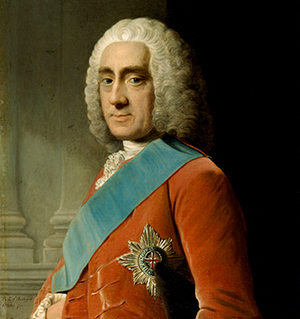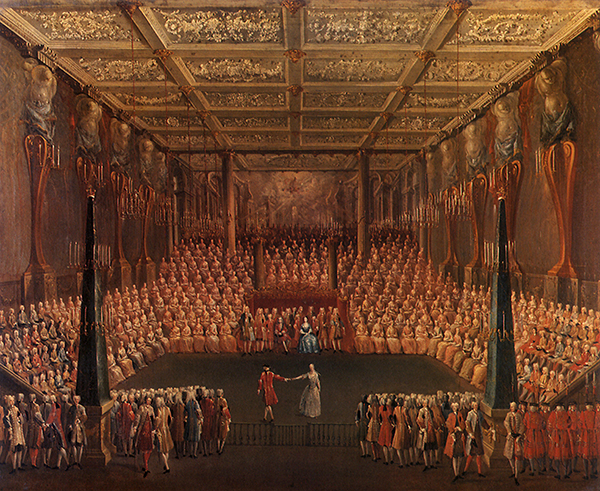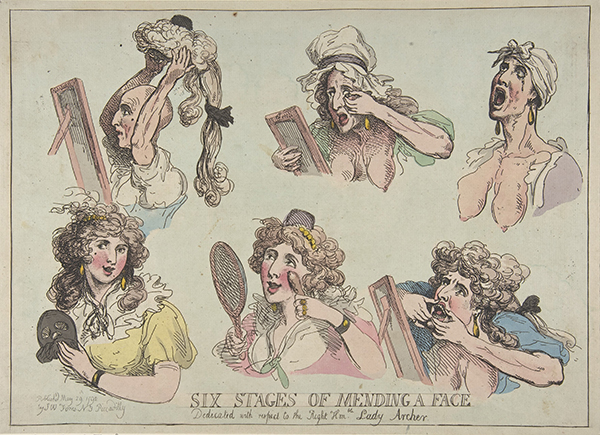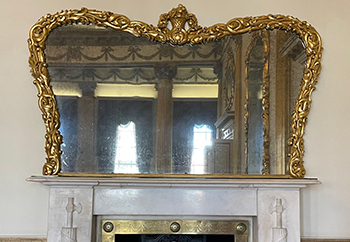‘BEAUTY IS PAIN … BUT ALSO POWER’—THE INFLUENCE OF CELEBRATED BELLES
Published in Features, Issue 1 (January/February 2022), Volume 30By Laura Fitzachary
‘It must, however, be remembered, when considering their good fortune, that in the day in which they lived beauty was all powerful’
—Francis Gerard, Some celebrated Irish beauties of the last century (1895).

Above: Lord Chesterfield—in the wake of the 1745 Jacobite rising in Scotland and England, the lord lieutenant reported to King George II that he ‘had only found one dangerous papist’ in Ireland, Eleanor Ambrose.
Dublin in the mid-eighteenth century had varying degrees of social hierarchy, and the highest level of social standing, or Irish high society, was often commented on by English visitors. Their scathing remarks usually pertained to Irish hospitality, etiquette and fashion, but what of any ‘Hibernian beauties’ who made their way through this gossip-filled socio-political terrain? The centre of British rule in Ireland, Dublin Castle, and its ballroom provided a stage for the cult of beauty. It also provided an opportunity for women considered to be ‘society belles’ to access the innermost circles at the Irish court and to partake in the conversations held therein. Others took the opportunity to hoist themselves onto the social ladder and marry upward. These women were of good birth and used the power that came through an obsession with beauty to their advantage. The likes of Maria Gunning (front cover) later took the cult of beauty to new heights (eventually becoming consumed by it), but even the most subtle displays of endearment caused a ripple in the sea of politics. It was in July 1745 that Eleanor Ambrose entered the ballroom at Dublin Castle. The prominent socialite was soon conversing with the viceroy, Lord Chesterfield. As they kept each other’s company, it was her status as a beauty that had got her there, but what was also interesting was that Eleanor Ambrose was a Catholic.
THE ‘DANGEROUS PAPIST’
In January 1745 Philip Stanhope, the 4th Earl of Chesterfield, began his administration as the lord lieutenant of Ireland, which was short but effective. With what has been described by Gerard as ‘genial influence’, Lord Chesterfield somewhat softened religious animosity in Ireland, while the Jacobite rising was taking place in Scotland and England in August that same year. When Chesterfield travelled over to London, he told King George II and his ministers that ‘it was poverty and not popery that the country had to fear’. He also added that, for his part, he ‘had only found one dangerous papist’. Upon further questioning from an inquisitive monarch, Chesterfield revealed that this was a beautiful young lady, whose ‘brightness of the eyes and charms of conversation were indeed perilous’. The nickname of ‘dangerous papist’ made Eleanor Ambrose famous.
Born at Ambrose Hall, Dublin, in 1718 or 1720 (sources vary), she was the daughter of a brewer and came from an old Catholic family with a large fortune. Though little is known of her early life, her acceptance in high society would have been somewhat hindered by her religion, but fortunately for her she was ‘gifted with exquisite beauty’. As noted by Gerard, ‘That miss Ambrose should be singled out as the belle par excellence of the viceregal court and be made the object of the viceroy’s particular attentions was a species of triumph to the Catholic party …’. When in 1745 Eleanor attended the ball in commemoration of the Battle of the Boyne, she not only took part in the rejoicing but also wore the colours of the dominant party. The bodice of her dress, like those of other court ladies, ‘was ornamented with the profusion of orange lilies’. Lord Chesterfield apparently wasn’t fooled by her ‘apparent loyalty’, later referring to her as the ‘fair traitress’ or ‘the pretty tory’.

Above: State ball held in the St Patrick’s Hall of Dublin Castle at the presence of the Viceroy and the Vicereine of Ireland by William van der Hagen (1731). The centre of British rule in Ireland, Dublin Castle, and its ballroom, provided a stage for the cult of beauty. (Alamy)
Chesterfield’s teasing jibes at Ambrose’s dress revealed both of their motives. By showing respect at a commemoration of Protestant victory, she could present herself as being aware of the current political climate and could befriend the viceroy. The viceroy then would use her socially accepted status as a belle to befriend a Catholic who was conversant with the political climate but who, as a woman, was not directly associated with a party. He kept her company at balls and while attending the theatre, where her beauty would receive the compliment of three cheers from the gallery. Her face may have gotten her a seat at the table but her conversations with, and suggestions to, Chesterfield must have made an impact. This deduction pops up again and again in contemporary ‘society papers’ and diary entries, noting how Ambrose’s views on the life of Catholics in Ireland led to Chesterfield opening schools and factories to combat poverty across the country. He also pacified both Protestant and Catholic factions to the extent that there was no Jacobite rising in Ireland.
Unfortunately, her words were not recorded, and it was not until much later in life that she reflected on the friendship and other political contacts that she made along the way. With such a ‘cultured mind’, it is not improbable to think that she made an impression on Chesterfield’s studies of the causes of poverty in Ireland and religious discrimination. He may indeed have been prompted to befriend her ‘by motives of policy,’ as an act to soften religious animosity, but her invaluable insight increased his sympathy.
She noted later how friends mocked her for wasting her time befriending the viceroy when it could have been better spent in choosing a husband from her many suitors. But interest in Eleanor’s hand had not faded after Chesterfield’s viceregal stint ended and he returned to England in November 1746. She married Roger Palmer of Castle Lackin, Co. Mayo, on 10 October 1750, and lived at her lodgings on Henry Street until her death in 1818, aged 98 or 100, seeing 27 more viceroys come and go at Dublin Castle. She was acquainted with Thomas Moore and Lord Byron and was visited by the politician and writer Richard Lalor Sheil, who noted that, ‘after the ordinary formulas of civility, she placed herself in a huge chair, and entered at once into politics. She was a most vehement Catholic … Lord Fingall and the Catholic question were the only subjects in which she seemed to take any interest.’ She watched generations be presented after her and outlived all her fellow beauties, such as Maria Gunning.

Above: Six Stages of Mending a Face, Dedicated with respect to the Right Hon-ble. Lady Archer by Thomas Rowlandson (1792), caricaturing the fading beauty of another eighteenth-century belle, Lady Sarah Archer. Many of the cosmetics used at the time were lead-based, causing damage to the digestive and nervous systems if overused. (Metropolitan Museum, New York)
THE CULT OF BEAUTY
Born in August 1732, Maria Gunning burst onto the London social scene in the same year that Ambrose got married. Born in Huntingdonshire, England, to Col. John Gunning of Castle Coote, Co. Roscommon, and Bridget, the daughter of Theobald Bourke, 6th Viscount Mayo, her childhood was spent in Ireland after her father inherited the family estates. Bridget noticed that both Maria and her younger sister Elizabeth were blossoming into beauties and, in the trope that is seen consistently in period dramas, she knew that she could use this beauty to improve the family’s current financial situation. John Gunning was a gambler who spent any lucky stroke he got on burgundy to fuel mistaken notions of hospitality and a ‘gentleman’s dignity’. Mrs Gunning scraped together whatever was left of their money and in 1748 moved the family (five children altogether) to Great Brittain Street (now Parnell Street), Dublin. The two eldest sisters attended a ball that season at Dublin Castle and, according to local gossiper Mrs Delaney, they completely won over the lord lieutenant. In letters to her sister in 1750, Delaney wrote that the viceroy kindly advised their proud mother, Mrs Gunning, to take her lovely daughters to London, ‘where there would be a proper field for the display of charms like theirs’—a larger stage, if you will. Delaney also noted their financial situation, but claimed that Maria in particular had a greater want than fortune—discretion. As a pair the sisters were considered coy but bold with enthusiasm, endearing country girls who ‘won an easy victory over the established beauties of Dublin including Miss Ambrose who was wearing the willow for the departed Chesterfield’.
By the time Maria and her sister arrived in London in autumn 1750, they had aroused considerable interest in fashionable society. The writings of Horace Walpole and Lady Luxborough fanned the hubbub around spotting the beauties—so much so that it reached the ears of the aging King George II, who also took a liking to them. Even though they lacked a fortune, both girls wed rather quickly. Maria married the 6th Earl of Coventry, with an estate at Croome Court, on 1 March 1752 in London, but had she achieved her goal? Marriage had secured a pension for her mother and a very comfortable life for Maria, delivering her from the fate of marrying locally and watching her father squander the family estate.
Despite what was deemed success, commotion around sightings of Maria continued. Lord Clermont described how one Sunday, when she was with her sister in St James’s Park, a crowd had formed to gaze at them; their curiosity turned violent, however, and the crowd became a mob pushing to catch a glimpse. He and the other gentlemen who were escorting the ladies had to draw their swords to protect them while they retreated to Lord Harrington’s house. The sisters were later described as frightened rather than flattered at ‘these proofs of the power of their beauty’. Horace Walpole commented on these frenzied sightings, noting that ‘beauties were more talked of than the change in the ministry’.
BEAUTY FADES …

Above: A mirror in the Throne Room of Dublin Castle, where from 1788 young débutantes were presented to the viceroy to mark their formal entry into aristocratic society. Before that, the space formed part of the ballroom where Eleanor Ambrose (1745) and Maria Gunning (1748) were presented.
The celebration of beauty in the eighteenth century created power, either in the form of access to politically charged conversations within certain circles, or by providing an opportunity to gain financial security. That power was fleeting, however, if it was ever tangible at all. The beholders of these beauties dictated the level of both Eleanor’s and Maria’s success, either through friendship and networking or through opportunity for marriage. Unfortunately, Maria Gunning lacked what her sister gained and what Eleanor Ambrose possessed—discretion. From public quarrels with her husband to altercations in the street with his mistress, and even to accusations of hiring security to walk in front of her during promenades, Maria’s name remained topical and at the tip of all the gossipers’ pens throughout the 1750s. Her reign, however, was to be short-lived. When her rise began to plateau, she tried to augment the very thing that had propelled her to fame in the first place by applying white lead-based face creams and rouges to her skin. Maria had applied cosmetics before, on a trip to Paris in 1753, much to her husband’s disdain. White face creams and powders were lead-based, causing the wearer to suffer from lead-poisoning if continuously used, damaging both the digestive and the nervous system. As her marriage broke down in the following years, by November 1759 one George Selwyn reported seeing her with the white and red paints that she now used ad libitum. He also noted that Lord Coventry no longer cared what she did and that she donned the paints so that she ‘could conceal the ravages her fatal illness had already made on her bright loveliness … she looked old, faded, a ghost of her former self …’.
This ‘fatal illness’ was the consumption that Maria had developed by 1758, the year of her last few public appearances. Her health had diminished significantly by the time of her encounter with Selwyn in 1759. Her final foray into a public setting was attending Lord Ferrers’s trial for treason in April 1760, and by that June there were already press reports of her death. She was in fact still alive, but had returned to Croome in late July, where she refused to go out and subsequently died there on 30 September 1760, aged just 28. Rumours swirled that she watched her beauty fade in hand mirrors and that her death was a result of lead-poisoning from using cosmetics, the irony being that such beauty products destroyed beauty itself. At Croome she was being treated daily for consumption, but if tuberculosis was indeed the final nail in the coffin, the continuous use of lead-based cosmetics had not helped.
Nineteenth-century commentators used the demise of such Irish beauties as Gunning to warning of the dangers of lead-based cosmetics. It was a factor in the untimely deaths of those who thought to augment their beauty, to stay relevant and continue their reign. Whilst the cult of beauty withstood (and aided) the death of Maria, Eleanor outlived the obsession, living through huge political and social change. These ‘fair Hibernians’ had different endings but displayed how an obsession with ‘female loveliness’ could be used to benefit a woman’s prospects in eighteenth-century Ireland, whether that was voicing a political stance or gaining financial security.
Laura Fitzachary is a museum educator in Dublin Castle and presents the history podcast Dublin’s Historic South.
Further reading
E.A.B. Barnard, ‘The Coventrys of Croome’, Transactions of the Worcestershire Historical Society 20 (1943).
F. Gerard, Some celebrated Irish beauties of the last century (London, 1895).
A. Webb, A compendium of Irish biography (Dublin, 1878).
















